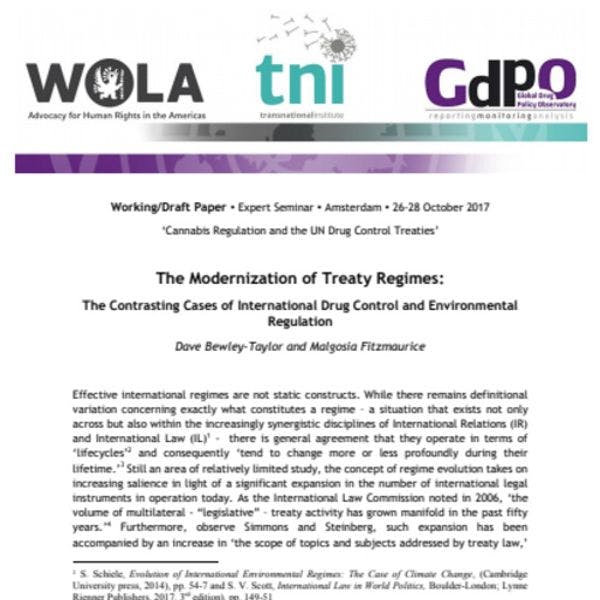La modernización de los regímenes de tratados internacionales: casos contrastados de fiscalización de drogas y regulación ambienta
El informe estudia la evolución del régimen de los tratados internacionales en materia de regulación ambiental y control de drogas. Más información, en inglés, está disponible abajo.
Effective international regimes are not static constructs. While there remains definitional variation concerning exactly what constitutes a regime – a situation that exists not only across but also within the increasingly synergistic disciplines of International Relations (IR) and International Law (IL) - there is general agreement that they operate in terms of ‘lifecycles’ and consequently ‘tend to change more or less profoundly during their lifetime.’ Still an area of relatively limited study, the concept of regime evolution takes on increasing salience in light of a significant expansion in the number of international legal instruments in operation today. As the International Law Commission noted in 2006, ‘the volume of multilateral - “legislative” – treaty activity has grown manifold in the past fifty years.’ Furthermore, observe Simmons and Steinberg, such expansion has been accompanied by an increase in ‘the scope of topics and subjects addressed by treaty law, with treaty growth being ‘especially marked in economic affairs, as well as in the areas of human welfare and the environment.’
Although various processes of regime evolution can be found across all three categories, this paper focuses on examples from the fields of human welfare (broadly defined) and the environment; more specifically the treaty regime based upon the United Nations (UN) drug control conventions and the regime of environmental regulation and its underpinning Multilateral Environmental Agreements (MEAs). With a basis in comparative analysis, our aim here is to explore how these multilateral treaty based regimes have altered and are capable of modernization over time in response to changes in circumstances and requirements of regime members. Moreover, within the context of shifts in the way that a growing number of jurisdictions are choosing to deal with the illicit use of cannabis within their territories, the paper seeks to demonstrate the extent to which the evolutionary capacity of what has been usefully called the ‘global drug prohibition regime’ (GDPR), can be considered out of step with a more dynamic regime like that dealing with transnational environmental concerns. In so doing, we hope to help move current discussions concerning the tensions presently surrounding the operation of the GDPR beyond the narrow confines of drug policy analysis and locate them within the broader context of IL, IR and wider investigation of regime evolution and modernization in general.
Beyond the fact that environmental regimes have been the subject of the most study on evolution and change, the focus on MEAs as a principle comparator to the GDPR rests on two factors. The first of these is the important, although very different, role that the advancement of scientific knowledge plays in the lifecycle of both regimes. The second relates to the regimes’ age and the associated structures and mechanisms that come with it. As will be discussed, such factors go some way to help explain why from an IL perspective the GDPR has been described as ‘Jurassic’ with its underpinning drug conventions ‘so stubbornly resistant to change compared to other treaty systems’ that they almost seem ‘“frozen in time.”’
The paper begins with an overview of the GDPR. This includes discussion of structural and normative mechanisms, processes and examples of regime ‘change’ and transformation as well as their limitations. It then moves on to an examination of MEAs and the key elements of the environmental regime that allow for change; the existence of a Conference or Meeting of the Parties and related legal structures allowing for the incorporation of far-reaching changes to environmental instruments. Examples of these mechanisms and other relevant features are explored specifically through structural analysis of the 1987 Montreal Protocol, the Convention on International Trade in Endangered Species of Wild Fauna and Flora (CITES) and the UN European Commission for Europe Convention on Access to Information, Public Participation in Decision-making and Access to Justice in Environmental Matters (the Arhus Convention).
Descargas
Temas
Regiones
Perfiles relacionados
- Global Drug Policy Observatory (GDPO)
- Transnational Institute (TNI)
- Washington Office on Latin America (WOLA)
